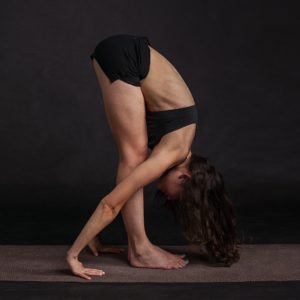
“My hamstrings are so tight” is an oft voiced complaint from many yoga practitioners. This comment is frequently heard when a student goes into a forward bend – sometimes with the expectation of wanting to touch their toes or the memory of formerly being able to touch their toes - and tight hamstrings means that it isn't possible to straighten the legs.
The hamstrings are a group of three muscles of the posterior thigh i.e. back thigh. They cross both the hip and knee joint and they attach to the sitting bones—the two large bones at the base of the buttocks (called the ischial tuberosities).
What do these muscles do?
Primarily the hamstrings work to extend the thigh (while standing with straight legs, lift one foot and extend leg back) and to flex the knee (while standing lift foot, bend knee and take foot towards buttock).
The hamstrings are used repeatedly; when you walk and run for example. Hamstrings tend to shorten and will continue to tighten when they are not regularly stretched. Sitting also tightens the hamstrings.
Overly tight hamstrings can affect your posture, the knees, hips and the health of the lower back. If your hamstrings are tight, you must be careful with either standing or sitting forward bends (the woman in the image has very open hamstrings).
In forward bending, the aim is to tilt the pelvis over the thighs at the hip joint, maintaining a long spine with no rounding. The pull of tight hamstrings inhibits this forward movement of the pelvis. In fact, the pelvis is being pulled backward in a position called "posterior tilt” and the normal curve of the lumbar spine (lower back) flattens.
While the pelvis is pulled backward, and you bend forward, you exert pressure on the lumbar spine and run the risk of straining the lower back, particularly the discs. To stay safe, bend forward from the hips and only go as far as you are able to with a straight spine. Concentrate on moving the pelvis forward, not your head. Bend your knees a little to help to maintain the length of the spine.
Here’s a simple test that you can do.
Lie on your back with one leg stretched out flat on the floor. Stretch the other leg up to the ceiling with a straight knee. Can you bring your leg to a vertical 90 degrees angle?
If you can't get to vertical, your pelvis will be posteriorly tilted in a forward bend, and it's possible that you would strain your back muscles or injure a disc if you reached for your toes.
You should avoid sitting forward bends, especially if you have a history of lower back pain or injury, until you can stretch your leg straight up to 90 degrees or more.
An excellent hamstring stretch which keeps the lower back safe is Supta Pandangusthansa (supine hand-to-toe pose), which we practise regularly in class lying on the flow, on your back, using a belt as part of the hip-series and standalone. I recommend that you practise this pose for a few minutes each day especially of your hamstrings are tight.

